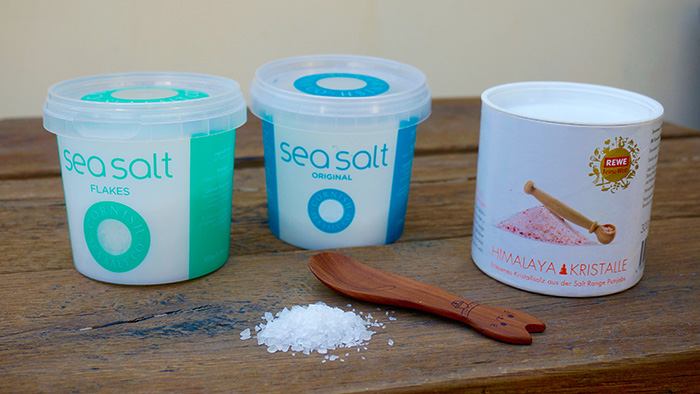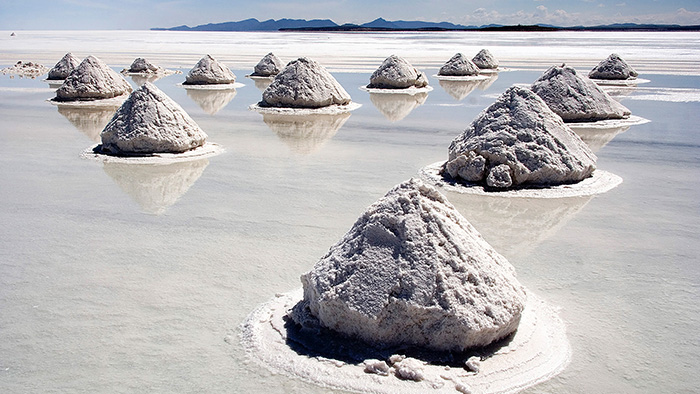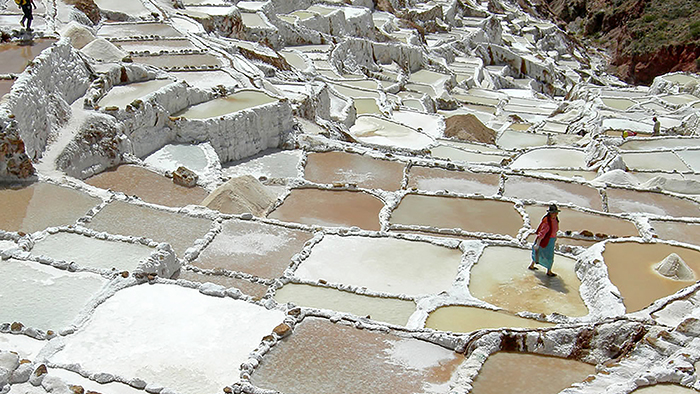Dear readers, we have covered many topics concerning right nutrition and fuelling on your adventures. One topic I have not discussed, even though extremely important, is SALT. Turns out, that when you start paying attention to your salt consumption, you may improve your health exponentially. There are lots of conflicting information out there, and today I will distil it down for you.
First of all, let me share with you a story, which made me think of salt: We invited my parents last October for two weeks to look after the garden and our cat while we went on holidays with my husband. A part of my mum’s entertainment was, of course, cooking food while we were away. About 10 days into our holidays I received a message from my mum with the picture of a finished whole Celtic sea salt container (which generally lasts for 6-8 months in my kitchen) asking, whether this was all salt I had in the house? At first I laughed in disbelief, but then I realised, how little information about quality and quantity of salt is out there and how much salt some people consume, thinking it is perfectly fine.
What is Salt and How Much do We Need?
Salt provides two elements – sodium and chloride – both of which are essential for life. Your body cannot make these elements on its own, so you must get them from your diet. However, not all salts are created equal. Unfortunately our regular table salt has become toxic for our bodies.

What is Wrong with Table Salt and Why you Should Avoid It?
Table salt is really sodium chloride (97.5 percent) which is salt that has been stripped of all its nutrients. The end result is a chemical, 90% of which is used for industrial purposes (like melting ice from public pavements in winter). The leftovers are marketed for consumers and used as preservatives for industrial foods. In addition, this kind of salt is typically coated with aluminium hydroxide, a heavy metal, in order to stop it clumping. Some other chemicals like moisture absorbents and flow agents like aluminosilicate and ferrocyanide are also added. Unfortunately, 95% of food in our common supermarkets carry processed foods which mostly contain table salt. It is an ingredient hidden in places you would least expect. That is why I recommend you stay away from processed foods as much as possible and pay attention to the labels.
However, that said, your body needs a good quality salt, be it sea salt, rock salt or Himalayan salt! Here is why!
Water and salt are the essences of life. As human body weight is some 60%-70% of salt water, staying properly hydrated (especially when exercising or undertaking any outdoor activities) is crucial. On the other hand, over hydration can be potentially dangerous and deadly too. Known as hyponatremia, drinking too much water without sodium and other minerals. This conditions has been a hot topic amongst some athletes who passed out suddenly during the races. Over hydration caused by water retention is often the result of medical conditions, such as liver disease, kidney problems, congestive heart failure and many more.
Did you know?
• Salt makes the body more conductive to electricity, allowing the cells to communicate better. Pure sea salt contains approximately 80 essential elements and minerals in their natural ratio that are essential for maintaining a healthy balance of electrolytes (sodium, potassium, chloride,
bicarbonate, etc.) in the body. This balance bolsters transmission of information between the brain and nerve cells, which, according to Neuropathyhelp.co and their guidelines, this influences heart rate, blood pressure and muscle tension, among other functions. Also, sea salt helps the kidneys get rid of excess acidity from body fluids while at the same time helping to regulate blood sugar levels.
• High salt solutions are used to resuscitate people and animals after injury, to increase blood volume to renew circulation, to restore cellular energy production, to increase oxygen consumption and heat production, to reduce free radical production, to improve heart muscle function, to reduce inflammation, vascular permeability and oedema (water retention) and to treat wounds!

What is the Difference Between Sea Salt, Rock Salt and Himalayan Salt?
Sea Salt
Sea salt is a natural unprocessed salt that contains about 84 percent sodium chloride (just under 37 percent of which is pure sodium). The remaining 16 percent are naturally-occurring trace minerals, including silicon, phosphorus, and vanadium.
Sea salt, also known as bay salt, is produced by the process of evaporation of salt water bodies. It is darker in colour as compared to the refined salts due to the absorption of essential minerals from the clay lining of the body of water.
Unlike refined salts, the preparation of sea salt usually includes very little processing, so it retains its moisture and mineral treasure. These minerals are present in a form that is easily utilised and absorbed by the human body. The climate and the geographical location of the region also play a significant role in the quality and combination of minerals offered by the sea salt.
The Mediterranean Sea, the Atlantic Ocean, and the North Sea are the most common hubs for the harvesting of sea salt. The method involved in harvesting sea salt also helps to retain its natural state and therapeutic qualities. In ancient times, sea salt was valuable for healing hand injuries and wounds of fishermen.
Celtic sea salt is harvested differently, and uses conventional Celtic methods. These methods involve working and collecting the salt entirely by hand, using only wooden tools. It does not contain harmful chemicals and additives therefore this is my favourite sea salts along with Cornish sea salt!
Himalayan salt
Himalayan salts came into existence 250 million years ago, when the Himalayan Mountains were being formed.
Himalayan crystal salt is a pure, stone ground, hand-mined salt that is derived from ancient sea salt deposits, and it is believed to be the purest form of salt available. The high mineral crystals range in colour from sheer white, varying shades of pink, to deep reds, the result of high mineral and iron content, particularly iron oxide.
It is called “white gold” because it is said to contain ions of stored sunlight and apparently has therapeutic properties.
This pure crystal has been exposed to earth pressure for millions and millions of years. This pressure has perfected the geometric crystalline structure of Himalayan salt. The more perfect the geometric shape of the crystal, the more its energy content. And with this structure, the body can easily absorb this salt.
Himalayan salt contains the 84 natural elements needed by the body. These salts do not have any impurities since they are mined with bare hands, and explosives are prohibited in mining to preserve the magnificence of the Himalayas.
The beauty with Himalayan salt is that in addition to being naturally lower in sodium, it’s much higher in potassium compared to other salt—including other natural salt like sea salt or Celtic salt. Himalayan salt contains 0.28 percent potassium, compared to 0.16 percent in Celtic salt, and 0.09 percent in regular table salt. While this may seem like tiny amounts, Himalayan salt still has a better salt-potassium ratio than other salt, especially table salt.
Being the cleanest salt, free from harsh chemicals, Himalayan Salt is used by holistic chefs, spas, health professionals, and individuals for its range of nutritional and therapeutic properties. Surely you have seen Himalayan crystal salt lamps around and I strongly recommend you buy at least one for your home and for your office. Some of the main benefits are, that they neutralise electromagnetic radiation (flowing from your TV, computers, phones etc., ), cleanse and deodorise air, reduce allergy and asthma, increase energy levels, improve mood and energy and reduce static energy in the air.
Externally, crystal salt can be used to relax the body, support healthy blood pressure already in the normal range, support healthy musculature, and aid in detoxification internally and externally (scrubbing).
Rock Salt
Rock salt is derived from the inside of mountains – the structure of the salt has been pressurised into a very fine colloidal form over millions of years. This kind of salt has a negative charge, whereas human cells are positively charged and as a result the minerals of the salt can be easily absorbed into human cells. Rock salt can balance the body’s potentially unhealthy resonance frequency and it can bring the fluids of the body into a correct balance.

Other Rather Unknown Benefits and Uses of Natural Salts:
• Pinch of sea salt diluted in a glass of water and drunk first thing in the morning could rid you of some food allergies.
• Use sea salt mouth rinse to treat gum swelling and sore throat.
• Make yourself a natural mouth rinse diluting one teaspoon of sea salt in warm water, add three drops of pure organic clove oil, leave to cool down and keep in your bathroom. Rinse your mouth daily after brushing, before going to bed.
• Use sea salt solution to disinfect wounds and cuts.
• Mix one cup of sea salt with one tablespoon of olive oil and use 1-2 a week to scrub your body (avoid face)
Make Yourself a Simple Sports Drink!
Mix juice from one organic freshly squeezed orange in your sports bottle filled up with filtered water.
Add 1/2 teaspoon of good quality sea salt or Himalayan salt (for more potassium) and drink throughout your exercise. This way you know exactly what is in your drink, you will be well hydrated and you avoid ingesting any harsh chemical commonly present in sports drinks.
The choice is yours! I personally keep a combination of all different salts in my kitchen cupboard and use them according to the texture of the meal, preparation and my mood. While sea salt is rather coarse, I use it to enhance the flavour of cooked meals or in a salt mill. My tip is to season your meals right at the end and using rather less than more. You will find that your meal will taste somewhat saltier few hours later when the salt crystals disintegrate.
Himalayan sea salt is said to carry energy and has healing powers. This is the kind of salt I would use to sprinkle on my ready veggies, in sports drinks or to balance flavour of some cold deserts. I also like to make my own matcha salt by mixing one cup of Celtic sea salt with two teaspoons of pure matcha powder. This way you will add some extra antioxidants to your meals plus the bright green colour is a simple pleasure to look at.
As you chase the healthiest possible life, be smart about what you put in your body. Remember that as with most things, moderation is the key. Avoid processed salt and use natural salt in moderation. Sea salt, rock salt and Himalayan salt are nutritional goldmines provided you mind sodium-potassium ratio. Eat a diet of whole, ideally organically and locally grown foods. Have a green juice every day, include lima beans, spinach, avocados, bananas, prunes and papayas to increase your potassium intake.
How Do I Know I Consume Enough/Too Much Sodium?
The only way is to have your levels tested by your doctor. As a general rule, your ideal sodium level should be 139, with an optimal range of 136 to 142. If it is much lower, you probably need to eat more salt (natural and unprocessed varieties, of course); if it is higher, you’ll likely want to restrict your salt intake. Keep in mind that if you have weak adrenals, you will lose sodium and need to eat more natural salt to compensate.

